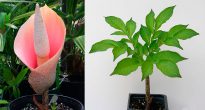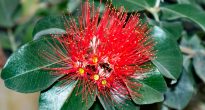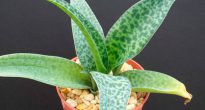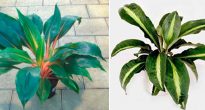Herbaceous plant neomarika (Neomarica) is directly related to the family of iris or iris (Iridaceae). In nature, it can be found in the tropical regions of South America. Such a plant is often called a walking or walking iris. The fact is that it is outwardly similar to a garden iris, and when the flowering ends, a baby is formed in the place where the flower was. It is located on top of a long (up to 150 centimeters long) peduncle. Gradually, under its own weight, the peduncle bends down more and more, and at some point the baby is on the surface of the soil, where it gives roots very quickly. It turns out that the baby is at some distance from the mother plant, which is why neomarika is called a walking iris.
Such a herb has leathery, flat, xiphoid leaves of a dark green color. Their length varies from 60 to 150 centimeters, and their width is 5–6 centimeters, while they are gathered in a fan. The formation of peduncles occurs directly on the leaves, and they bear from 3 to 5 flowers. Such fragrant flowers last from 1 to 2 days. They are painted in a pale milky color and have bluish veins in the throat, and their diameter can be equal to 5 centimeters. At the end of flowering, wilted flowers fall off, and a baby (a small rosette of leaves) is formed in their place.
Content
Caring for neomarika at home
Illumination
Lighting should be bright, but diffuse. Needs direct rays of morning and evening sun. In the summer, shading is required from the scorching midday sun rays (approximately from 11 to 16 hours). In winter, there is no need to shade the plant.
Temperature regime
In the warm season, the plant grows normally and develops at normal room temperature. In winter, it is recommended to rearrange the neomarica to a cooler place (from 8 to 10 degrees) and reduce watering. In this case, flowering will be more abundant.
Humidity
Moderate air humidity is ideal for such a plant. It is recommended to moisten the foliage with a sprayer when wintering in a warm place and on hot summer days. If heating devices are working in the room, then the flower can be systematically arranged with a warm shower.
How to water
In the summer, watering should be plentiful, and with the onset of the autumn period, watering is gradually reduced. If the plant hibernates in a cool place, then water it very sparingly.
Dormant period
The dormant period lasts from October to February.At this time, neomarika is placed in a cool (5-10 degrees) well-lit place.
Top dressing
In the wild, such a flower prefers to grow on depleted soils, so it does not need frequent and intensified feeding. If you wish, you can feed him from May to June 1 or 2 times in 4 weeks. For this, fertilizer for orchids is suitable.
Transplant features
Young specimens need an annual transplant, and adults can be subjected to this procedure once every 2 or 3 years. The plant is transplanted in the spring. A suitable soil mixture consists of peat, turf soil and sand, taken in a 1: 2: 1 ratio, and you need to add soil for heather or coniferous litter to it. The acidity should be at a pH of 5.0-6.0. Tanks need low and wide. Do not forget to make a good drainage layer at the bottom.
Reproduction methods
As a rule, children are used for reproduction, which are formed at the ends of the peduncles. Experts recommend placing a container of soil directly under the bent child. Tilt the peduncle so that the baby is on the surface of the ground, and fix it with a wire bracket in this position. Rooting will take place after 2-3 weeks, after which the peduncle should be carefully trimmed.
Main types
Neomarica slender (Neomarica gracilis)
This herb is quite large in size. Leathery xiphoid leaves collected in a fan are colored green. Their length varies between 40-60 centimeters, and the width is 4-5 centimeters. The opening of the flowers on the peduncles occurs gradually. The peduncles themselves bear up to 10 flowers with a diameter of 6 to 10 centimeters. The flower withers a day after opening. So, in the morning it begins to open, in the daytime it reaches full disclosure, and in the evening it fades.
Neomarica northiana
It is a herbaceous plant. Its leaves are flat and leathery. Their length varies from 60 to 90 centimeters, while the width is 5 centimeters. The diameter of the fragrant flowers is 10 centimeters, their color is lavender or violet-blue with white.
















